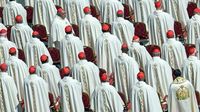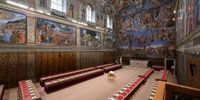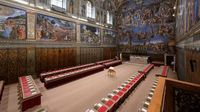On Wednesday, May 7, 2025, the Vatican will witness a historic moment as 133 cardinals from 70 countries gather to begin the conclave, the most geographically diverse in the Catholic Church's 2,000-year history. This conclave marks a significant departure from tradition, as Pope Francis appointed 108 of the participating cardinals, many from nations like Mongolia, Sweden, and Tonga, which had never before had a cardinal. The decision to exceed the usual limit of 120 electors injects an unusual degree of uncertainty into a process already shrouded in mystery.
As the cardinals prepare to enter the Sistine Chapel for the election of the 267th Pope, they will be isolated from the outside world. Starting at 3:00 PM local time (7:00 AM Central Mexico time), telephone signals within the Vatican will be cut off to prevent any external communication. Their mobile phones will be collected, and the cellular connection around the Vatican will be blocked, ensuring that the cardinals can focus solely on their sacred duty.
The conclave will commence officially with a mass at 10:00 AM in St. Peter's Basilica, presided over by Cardinal Giovanni Battista Re, the Dean of the College of Cardinals. This mass, known as “Pro eligendo Pontifice,” serves as a prayer for wisdom and guidance as the cardinals embark on the weighty task of selecting a new leader for the Catholic Church, which boasts approximately 1.4 billion followers worldwide.
At 4:30 PM, the cardinals will solemnly enter the Sistine Chapel, where they will take an oath of secrecy before the Gospel. This oath binds them to confidentiality regarding all matters related to the election of the new pontiff. The atmosphere will be charged with anticipation as they chant the litany of saints and the hymn "Veni Creator Spiritus," invoking the Holy Spirit's assistance in their deliberations.
Once inside, Monsignor Diego Ravelli will announce the traditional “Extra omnes,” signaling the exit of all non-voting individuals. The doors will then close, sealing the cardinals within the chapel as the voting process begins. The first vote is scheduled for later that afternoon, and if no candidate receives the necessary two-thirds majority, black smoke will emerge from the chimney around 7:00 PM, indicating that no pope has been elected.
The voting procedure is meticulous. Each cardinal will write their choice on a ballot inscribed with the words “Eligo in summen pontificem,” meaning "I elect as Supreme Pontiff." They will approach the altar one by one, declaring, "I call Christ the Lord to witness, who will be my judge, that my vote is given to him who, before God, I believe should be elected." The ballots will be collected in a silver and gold urn and later counted by three scrutineers, randomly selected cardinals. The results will determine whether the smoke from the chapel will be black or white, the latter signaling the election of a new pope.
As the cardinals engage in this sacred process, they are aware of the weight of their decisions. The conclave is expected to last several days, with up to two votes held each morning and afternoon until a new pope is chosen. Historical precedents suggest that the election could take anywhere from three to eight ballots, as seen in past conclaves. For instance, John Paul I was elected on the third ballot, while John Paul II required eight votes, and Francis was chosen in the fifth round.
The context surrounding this conclave is particularly dynamic. Following the death of Pope Francis on April 21, 2025, the cardinals have gathered not only to elect a new pope but also to address pressing issues within the Church, including financial matters, the ongoing sex abuse scandal, and the need for unity among the faithful. During their preparatory meetings, the cardinals have made calls for peace in regions plagued by conflict, such as Ukraine and the Middle East, and have discussed the profile of the next pope, envisioning a leader who embodies compassion and understanding.
As the world watches, thousands of people will gather in St. Peter's Square, eagerly awaiting the first sign of smoke from the Sistine Chapel. The sight of white smoke will signal the election of a new pope, a moment steeped in historical significance. The announcement will be made by Cardinal Dominique Mamberti, who will proclaim, "Annuntio vobis gaudium magnum: Habemus papam!"—"I announce to you with great joy: We have a pope!" This moment not only marks the selection of a new leader but also signifies a new chapter for the Catholic Church.
The conclave's proceedings are a blend of solemnity and tradition, with the cardinals committed to maintaining secrecy and focus as they navigate this pivotal moment. With a diverse group of electors and a backdrop of contemporary challenges, the outcome of this conclave promises to shape the future of the Catholic Church for years to come. As the cardinals prepare to cast their votes, the world waits with bated breath to see who will emerge as the next spiritual leader of over 1.4 billion Catholics globally.






